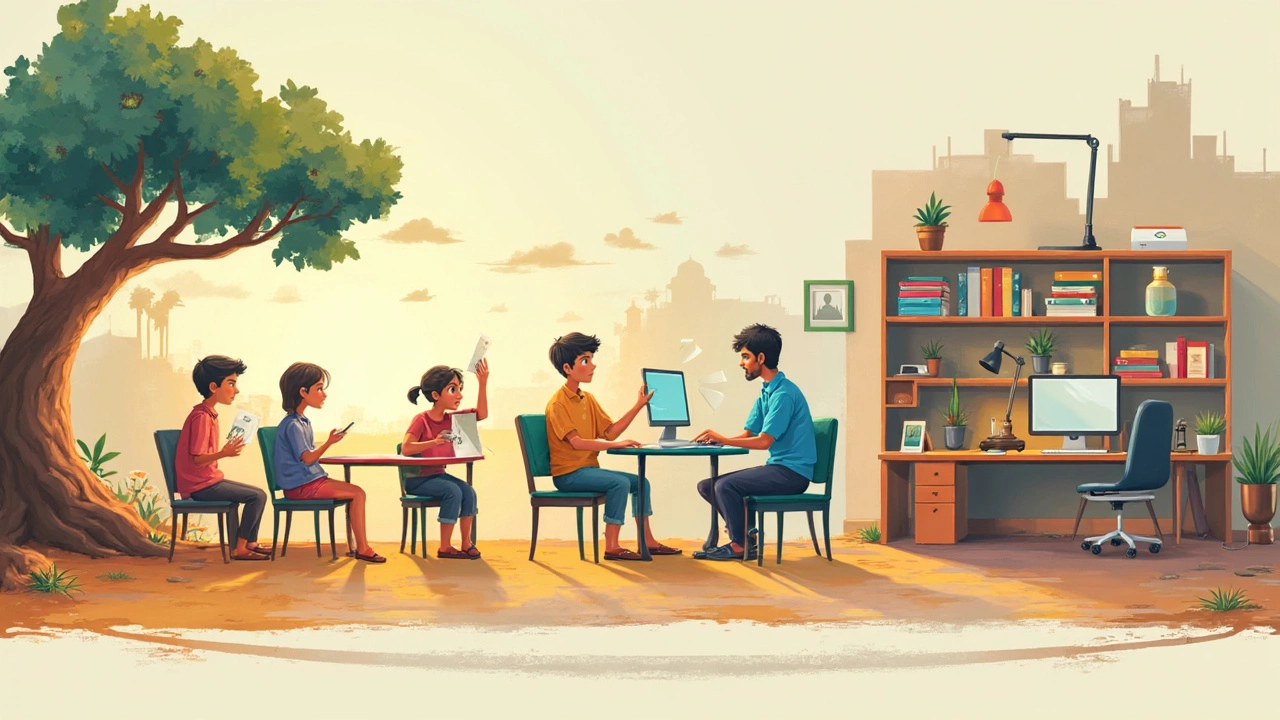Ever wondered how distance learning became such a big deal? Well, it's not just a result of recent tech booms. Believe it or not, it all started back in the 19th century with good old snail mail. Yeah, that's right—people used to receive their study materials through the post! The University of London was among the pioneers in the 1850s, offering correspondence courses to students who couldn't be there in person.
Fast forward a bit, and the digital age flip-turned the story with the internet making learning from home easier and more engaging. Remember dial-up internet? That was the beginning of digital distance learning as we know it. Schools started experimenting with online classes, and despite some technical hurdles, it actually worked. Now, learning at your own pace and place feels like the new normal.
- Early Beginnings
- The Rise of Online Learning
- Technological Breakthroughs
- Tips for Modern Distance Learners
Early Beginnings
So, how did distance learning actually get started? Believe it or not, it goes way back to the 1800s. In those days, it was all about correspondence courses. Imagine having your study materials and lessons delivered through the mail. Sounds vintage, right? But it worked!
Take the University of London for example. Back in 1858, they shook things up by offering examination programs that you could complete from anywhere in the world as long as you had a postal address. This was a total game changer at the time because it meant you didn't have to live near a university to get an education!
The 19th-Century Correspondence Revolution
Workers and ambitious minds who couldn't quit their jobs to attend class now had a chance to keep learning on the side. This period also saw the rise of schools like Wolsey Hall in Oxford, which started up around 1894. These were pioneers, using the post office to bridge gaps in education access.
Didn't have time to attend a physical class? No problem! People studied at home and mailed their assignments back for grading. Imagine the patience required waiting for feedback! It's worth mentioning that by the late 1800s, this system had spread to the United States too, with places like the University of Chicago embracing it.
Printed Materials and Lessons by Mail
These early programs mainly relied on printed materials—literally the textbooks and worksheets needed to study. All these were sent by mail. While it might seem a bit slow compared to our fast-paced world, it was revolutionary at the time. Education history shows this model laid the foundations for what we know now as open and distance learning.
| Year | Milestone |
|---|---|
| 1858 | University of London offers distance examination programs |
| 1894 | Wolsey Hall, Oxford starts correspondence courses |
| 1892 | University of Chicago adopts correspondence learning |
So, next time you attend an online lecture or tune into a virtual class, remember that this whole remote learning thing is standing on the shoulders of some pretty epic history!
The Rise of Online Learning
The dawn of the digital era really takes the credit for pushing distance learning to the next level. In the late 1990s and early 2000s, the internet shifted from being a luxury to a household staple. This opened up endless possibilities for remote education, giving students access to a world of information with just a few clicks.
Early Adopters and Platforms
Early pioneers like the University of Phoenix and Open University in the UK began experimenting with online courses. Websites like Blackboard and Moodle came into the scene, offering platforms that schools could use to deliver coursework, host discussions, and even administer tests.
These platforms were game-changers, allowing educators to easily organize course materials and communicate with students, no matter where they were in the world. And students? They could now learn at their own pace, without the need to commute to a physical location.
Online Learning Explosion
In the last decade, online course popularity shot through the roof with platforms like Coursera, Udemy, and edX offering courses from top universities like Stanford, Harvard, and MIT. Suddenly, a student in a small town could access the same quality education as someone sitting in a lecture hall at a big-name school.
| Year | Number of Online Platforms | Number of Users (millions) |
|---|---|---|
| 2010 | 200 | 1.4 |
| 2020 | 700 | 14.5 |
Challenges and Innovations
Of course, it wasn't all smooth sailing. Early on, tech limitations and slow internet speeds were a hassle. But every challenge led to innovation. The arrival of faster internet, better software, and new teaching approaches made online learning more seamless than ever.
Additionally, as online courses become more prevalent, focus shifted to ensuring quality. Accreditation processes were put in place, ensuring the courses delivered were up to par with in-person ones.
In essence, the rise of online learning has been about breaking barriers—geographically, financially, and educationally. It's about giving everyone the chance to learn what they want, when they want, all thanks to the ever-evolving digital world.

Technological Breakthroughs
Technological advancements have been a game-changer, pushing distance learning from the dusty old pages of snail mail to the dynamic world of online platforms. The introduction of the World Wide Web in the 1990s was a real turning point. Suddenly, students could access educational content with a few clicks, setting the stage for more interactive and immersive learning experiences.
From Dial-Up to Broadband
Initially, the struggle was real with dial-up connections that made loading pages a test of patience. But as broadband internet spread its wings in the 2000s, streaming videos and attending virtual classes turned from a hopeful dream into an everyday reality. Faster internet didn’t just mean better accessibility; it revolutionized how effective remote learning could be.
The Rise of Learning Management Systems
Then came the emergence of Learning Management Systems (LMS) like Blackboard and Moodle, which transformed how educational institutions delivered online courses. These systems allowed for a structured way to post lectures, assignments, and grades, providing a cohesive learning experience tailored to individual needs.
Interactive Tools and Virtual Classrooms
The boom in video conferencing tools like Zoom and Microsoft Teams has arguably been one of the most significant leapfrogs. These platforms do a fantastic job of mimicking the traditional classroom feel, complete with live discussions and collaborative workspaces. They’re a godsend for anyone striving for that classroom community vibe while still enjoying the perks of remote education.
Data Visualizing the Growth
Curious about the trajectory of this tech evolution? Just take a peek at the increasing number of institutions adopting remote learning platforms over the years.
| Year | Institutions Adopting LMS |
|---|---|
| 2000 | 5% |
| 2010 | 43% |
| 2020 | 80% |
With more breakthroughs on the horizon (hello, AI and VR!), the landscape of distance education is bound to keep evolving. And while technology keeps changing, the essence of learning—curiosity and knowledge—remains beautifully the same.
Tips for Modern Distance Learners
Learning from the comfort of your home sounds like a dream, right? But it's also full of its unique challenges. Fear not—I've got some practical tips to help you succeed in your distance learning journey.
Create a Dedicated Study Space
First things first, set up a space where you can focus. Whether it's a corner of your bedroom or a kitchen table, having a dedicated study area will help keep distractions at bay and get you in the right headspace for learning.
Stick to a Schedule
This might seem obvious, but it's surprisingly easy to lose track of time when you're learning online. Create a realistic study schedule and stick to it, just as you would with in-classroom learning. Setting reminders can help you stay on track.
Engage with the Material
Interacting with course materials is key. Take notes during lectures, participate in online discussions, and always try to relate new concepts to what you already know. The more you engage, the better you'll understand and remember the material.
Stay Connected
Don't underestimate the power of community! Join study groups or online forums related to your course. Sharing insights and asking questions helps solidify what you're learning, plus it connects you with other distance learners who might be going through similar challenges.
Self-Care is Key
Yeah, learning is important, but don’t forget to look after yourself. Whether it's taking a walk or grabbing a healthy snack, short breaks are crucial for maintaining focus and energy throughout the day.
Use Available Resources
Most courses offer extra materials like recorded lectures, reading lists, and even tutoring. Make the most out of these resources—they're designed to help you!
Understand Technology
Getting familiar with the tech you'll be using can save you a lot of headaches. Whether it's the learning platform or communication tools, knowing how to navigate these will make the learning experience much smoother. Keep software updated to avoid technical issues.
Feeling ready to tackle your remote learning like a pro? With these tips, you'll be better equipped to handle the ups and downs of the world of online courses. The key is balance—mix discipline with well-deserved breaks, and you're on the road to success!
